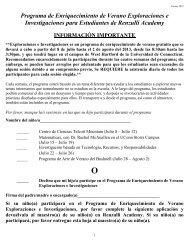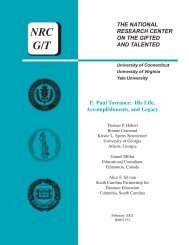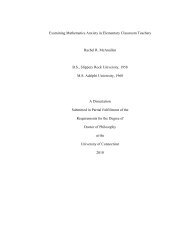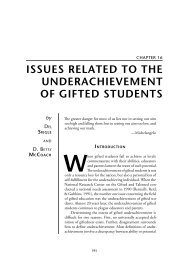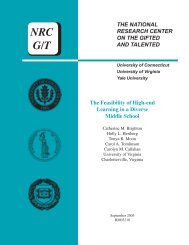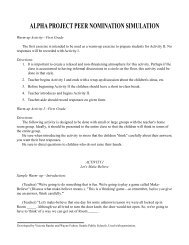Giftedness and High School Dropouts - Neag Center for Gifted ...
Giftedness and High School Dropouts - Neag Center for Gifted ...
Giftedness and High School Dropouts - Neag Center for Gifted ...
You also want an ePaper? Increase the reach of your titles
YUMPU automatically turns print PDFs into web optimized ePapers that Google loves.
5<br />
CHAPTER 2: Review of the Literature<br />
Definition of <strong>Dropouts</strong><br />
A dropout is generally considered to be a student who has withdrawn from a<br />
school without graduating or completing a program of studies <strong>for</strong> any reason except death<br />
or transfer (Ascher & Schwartz, 1987; French, 1969; Sadowski, 1987). The U.S. Office<br />
of Education defined dropout as:<br />
. . . a student who leaves a school, <strong>for</strong> any reason except death, . . . who has been<br />
in membership during the regular school term, <strong>and</strong> who withdraws . . . be<strong>for</strong>e<br />
graduating . . . or completing an equivalent program of studies . . . . [He or she] is<br />
considered a dropout whether . . . dropping out occurs be<strong>for</strong>e or after (reaching)<br />
compulsory school attendance age. (Bernoff, 1981, p. 19)<br />
Although there is general consensus of the definition of dropouts, some<br />
researchers indicated that there are definition problems especially because dropout rates<br />
are inaccurate due to the definition problem. Strother (1986) described the problem of<br />
definition as follows:<br />
The record suggested that dropping out is a serious problem but that there is little<br />
agreement on the definition of a dropout. Some districts change the definition<br />
from year to year, <strong>and</strong> many districts define dropout to match the purpose <strong>for</strong><br />
which the statistics are being kept. Cities or states sometimes put pressure on<br />
school districts to keep records in such a way as to make the dropout rate appear<br />
low. Moreover, school districts calculate the dropout rate in different ways.<br />
Many of them count only high school students. Nor does a st<strong>and</strong>ard system exist<br />
<strong>for</strong> keeping records on dropouts. Because the definitions vary, estimates of the<br />
number of dropouts also vary. (p. 326)<br />
Further, Ascher, <strong>and</strong> Schwartz (1987) explained why counting dropouts is difficult:<br />
Counting dropouts is even more difficult than determining who they are because<br />
no system based on student numbers counted at a particular point in time, can<br />
correctly reflect the status of every student. Moreover, it is the ability of the staff<br />
member inputting data to accurately evaluate every student's status in the face of a<br />
great volume of in<strong>for</strong>mation that ultimately determines the quality of a dropout<br />
analysis. While the basis of all dropout rates is the difference between the<br />
number of students enrolled at two different points in time, the points chosen by<br />
school vary widely: September <strong>and</strong> September, September <strong>and</strong> June, November<br />
<strong>and</strong> June, the beginning term of the school's lowest grade level <strong>and</strong> that class's<br />
normal graduation date. (p. 2)




